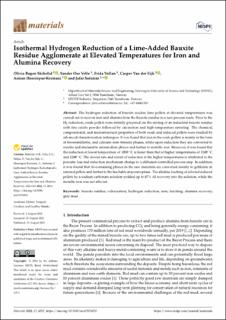| dc.contributor.author | Olivia Bogen, Skibelid | |
| dc.contributor.author | Ose Velle, Sander | |
| dc.contributor.author | Vollan, Frida | |
| dc.contributor.author | Eijk, Casper van der | |
| dc.contributor.author | Hoseinpur Kermani, Arman | |
| dc.contributor.author | Safarian, Jafar | |
| dc.date.accessioned | 2022-09-05T06:22:50Z | |
| dc.date.available | 2022-09-05T06:22:50Z | |
| dc.date.created | 2022-08-31T15:00:33Z | |
| dc.date.issued | 2022 | |
| dc.identifier.citation | Materials, 2022, 15, 6012, 1-17. | en_US |
| dc.identifier.issn | 1996-1944 | |
| dc.identifier.uri | https://hdl.handle.net/11250/3015616 | |
| dc.description.abstract | The hydrogen reduction of bauxite residue lime pellets at elevated temperatures was carried out to recover iron and alumina from the bauxite residue in a new process route. Prior to the H2 reduction, oxide pellets were initially prepared via the mixing of an industrial bauxite residue with fine calcite powder followed by calcination and high-temperature sintering. The chemical, compositional, and microstructural properties of both oxide and reduced pellets were studied by advanced characterization techniques. It was found that iron in the oxide pellets is mainly in the form of brownmillerite, and calcium–iron–titanate phases, while upon reduction they are converted to wüstite and shulamitite intermediate phases and further to metallic iron. Moreover, it was found that the reduction at lower temperature of 1000 °C is faster than that at higher temperatures of 1100 °C and 1200 °C. The slower rate and extent of reduction at the higher temperatures is attributed to the porosity loss and reduction mechanism change to a diffusion-controlled process step. In addition, it was found that Al-containing phases in the raw materials are converted mainly to gehlenite in sintered pellets and further to the leachable mayenite phase. The alkaline leaching of selected reduced pellets by a sodium carbonate solution yielded up to 87% Al recovery into the solution, while the metallic iron was not affected. | en_US |
| dc.language.iso | eng | en_US |
| dc.publisher | MDPI | en_US |
| dc.rights | Navngivelse 4.0 Internasjonal | * |
| dc.rights.uri | http://creativecommons.org/licenses/by/4.0/deed.no | * |
| dc.subject | grey mud | en_US |
| dc.subject | alumina recovery; | en_US |
| dc.subject | leaching; | en_US |
| dc.subject | iron; | en_US |
| dc.subject | hydrogen reduction; | en_US |
| dc.subject | valorization; | en_US |
| dc.subject | bauxite residue; | en_US |
| dc.title | Isothermal Hydrogen Reduction of a Lime-Added Bauxite Residue Agglomerate at Elevated Temperatures for Iron and Alumina Recovery | en_US |
| dc.title.alternative | Isothermal Hydrogen Reduction of a Lime-Added Bauxite Residue Agglomerate at Elevated Temperatures for Iron and Alumina Recovery | en_US |
| dc.type | Peer reviewed | en_US |
| dc.type | Journal article | en_US |
| dc.description.version | publishedVersion | en_US |
| dc.rights.holder | Copyright: © 2022 by the authors. Licensee MDPI, Basel, Switzerland. This article is an open access article distributed under the terms and conditions of the Creative Commons Attribution (CC BY) license (https:// creativecommons.org/licenses/by/ 4.0/). | en_US |
| dc.source.pagenumber | 17 | en_US |
| dc.source.volume | 15 | en_US |
| dc.source.journal | Materials | en_US |
| dc.identifier.doi | 10.3390/ma15176012 | |
| dc.identifier.cristin | 2047651 | |
| dc.relation.project | EC/H2020 958307 | en_US |
| dc.source.articlenumber | 6012 | en_US |
| cristin.ispublished | true | |
| cristin.fulltext | original | |
| cristin.qualitycode | 1 | |

